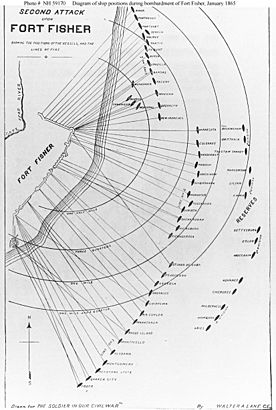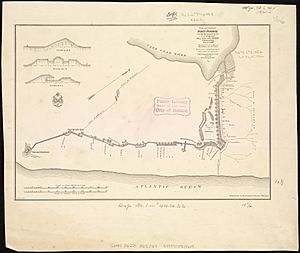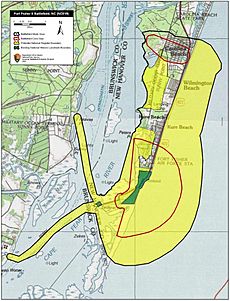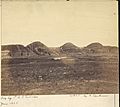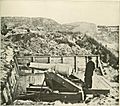Second Battle of Fort Fisher facts for kids
Quick facts for kids Second Battle of Fort Fisher |
|||||||
|---|---|---|---|---|---|---|---|
| Part of the American Civil War | |||||||
 Capture of Fort Fisher by Kurz and Allison, 1890 |
|||||||
|
|||||||
| Belligerents | |||||||
| Commanders and leaders | |||||||
| Units involved | |||||||
|
Department of Virginia and North Carolina:
|
Fort Fisher Garrison Hoke's Division |
||||||
| Strength | |||||||
|
1,900 (Fort Fisher) 6,400 (Hoke's Division) |
||||||
| Casualties and losses | |||||||
|
1,900 (583 killed and wounded; entire Fort Fisher garrison captured) | ||||||
The Second Battle of Fort Fisher was a big fight near the end of the American Civil War in January 1865. The Union Army, Navy, and Marine Corps worked together to attack Fort Fisher. This fort was located south of Wilmington, North Carolina.
Fort Fisher was very important to the Confederacy. People called it the "Gibraltar of the South." It was the last major port on the coast that the Confederacy still controlled. This fort helped protect ships called blockade runners. These ships brought important supplies to the Confederate Army of Northern Virginia.
Contents
Why Fort Fisher Was Important
Wilmington was the last big port the Confederacy could use on the Atlantic coast. Ships leaving Wilmington used the Cape Fear River. They sailed to places like the Bahamas, Bermuda, or Nova Scotia. There, they traded cotton and tobacco for supplies from the British. Fort Fisher protected these ships.
The fort was built mostly from earth and sand. This design was based on a fort in Russia called the Malakoff redoubt. Being made of earth helped it survive heavy cannon fire from Union ships. Older forts made of brick and mortar would have been destroyed more easily.
Fort Fisher had 22 guns facing the ocean and 25 guns facing the land. The guns facing the sea were on high platforms. There were also underground tunnels and bombproof rooms inside the fort. These strong defenses kept Union ships from attacking Wilmington and the Cape Fear River.
In December 1864, Union ships led by Rear Admiral David D. Porter tried to bomb the fort. It didn't do much damage. Then, on December 25, Union troops started to land for a ground attack. But their leader, Major General Benjamin F. Butler, pulled them back. He heard that Confederate reinforcements were coming.
Who Fought at Fort Fisher
The Union Forces
The Union Army came back in January 1865. This time, Major General Alfred Terry was in charge. Lieutenant General Ulysses S. Grant chose Terry to lead about 9,000 soldiers. Rear Admiral David D. Porter also returned. He brought almost 60 ships from the North Atlantic Blockading Squadron.
The Confederate Defenders
Confederate Major General W.H.C. Whiting was in command of the area. He asked General Braxton Bragg for more soldiers. Bragg was worried about taking soldiers away from defending Wilmington. But he finally sent some reinforcements. This brought the total number of soldiers at Fort Fisher to 1,900. Another 6,400 Confederate troops were north of the fort. They were led by Major General Robert Hoke.
General Whiting went to the fort and told its commander, Colonel William Lamb: "Lamb my boy, I have come to share your fate. You and your garrison are to be sacrificed." This showed how serious the situation was.
The Battle Begins
Alfred Terry had fought in other battles before. He knew it was important to work closely with the Union Navy. He and Admiral Porter made good plans for their joint attack.
Terry planned to send one group of United States Colored Troops to stop Hoke's Confederate soldiers. His other group of soldiers would attack the fort from the land side. Admiral Porter organized a group of 2,000 sailors and marines. They would land and attack the fort from the sea side.
On January 13, Terry landed his troops between Hoke's forces and Fort Fisher. Hoke did not attack, so the Union soldiers landed safely. The next day, Terry moved closer to the fort. He looked at the fort and decided that his soldiers could attack it on foot.
The Main Attack
On January 15, Porter's ships started firing at the fort's sea side. By noon, they had silenced almost all of the fort's guns. During this attack, Hoke sent about 1,000 soldiers to Fort Fisher. But only about 400 of them made it into the fort.
Around this time, 1,600 sailors and 400 marines landed. They were led by Lieutenant Commander Kidder Breese. They moved to attack the part of the fort where the land and sea walls met. This area was called the Northeast Bastion. The Union plan was for the naval force to attack in waves. But instead, they attacked all at once and without much organization. General Whiting personally led the Confederate defense. They fought back hard, and many Union sailors and marines were hurt.
This attack, however, made the Confederates focus on the sea side. This allowed the Union Army to prepare their attack on the river side of the fort. At 2:00 p.m., the Union Army began its assault. Union soldiers used axes to cut through the wooden fences and obstacles. They faced heavy fire but fought their way into the fort.
As the Union soldiers pushed forward, Confederate snipers shot at them. General Whiting led a counterattack himself. He was shot and badly wounded. The Union ships continued to help. Their accurate firing cleared out Confederate defenders.
Colonel Lamb, the fort's commander, gathered every soldier he could find. This included sick and wounded men from the hospital. He was about to order a final charge when he was also badly wounded. He was taken to the hospital next to General Whiting.
The battle was very tough and lasted for hours, even after dark. Union soldiers kept fighting, but their leaders were getting hurt. Terry sent more soldiers to help. Meanwhile, in the hospital, Lamb gave command to Major James Reilly. Whiting sent one last message to General Bragg asking for more help. Bragg thought the fort was still safe. He sent General Alfred H. Colquitt to take over command at Fort Fisher. Colquitt landed at the fort around 9:30 p.m.
The Fort Falls
At this point, the Confederates could not hold Fort Fisher any longer. The guns facing the sea were silent. Almost all of the north wall was captured. The Union Army had taken control of a strong position inside the fort. Terry decided to finish the battle that night.
Union soldiers moved around the land wall to get behind the Confederate defenders. Within minutes, it was clear the Confederates had lost. Colquitt and his staff quickly left. Major Reilly raised a white flag to surrender the fort. Just before 10:00 p.m., Terry rode to the fort to officially accept the surrender from General Whiting.
After the Battle
Losing Fort Fisher meant that Wilmington, the Confederacy's last seaport, was no longer safe or useful. The South was now cut off from trade with other countries. Many military supplies for the Army of Northern Virginia came through Wilmington. There were no other nearby seaports the Confederates could use. This loss was a huge blow to the Confederacy. A month later, a Union army captured Wilmington.
On January 16, a day after the battle, the fort's gunpowder storage area exploded. This killed and wounded about 200 Union soldiers and Confederate prisoners. They had been sleeping on or near the storage room. An investigation found that Union soldiers had accidentally caused the explosion.
Colonel Lamb survived the battle but needed crutches for seven years. General Whiting was captured and later died while being held by the Union. Many Union officers were also wounded, but some received special honors for their bravery. Two of them, Newton Martin Curtis and Galusha Pennypacker, received the Medal of Honor. Pennypacker became the youngest general in the U.S. Army at age 20.
Medals of Honor
During the Battle of Fort Fisher, 51 soldiers, sailors, and marines received the Medal of Honor. This is a very high award for bravery.
Images for kids


